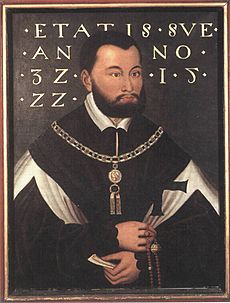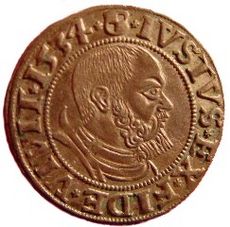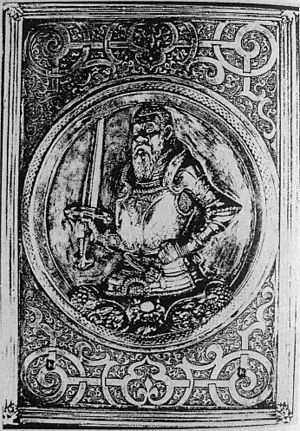Albert, Duke of Prussia facts for kids
Quick facts for kids Albert |
|
|---|---|
| Grand Master of the Teutonic Knights Duke of Prussia |
|

Albert of Prussia, painting by Lucas Cranach the Elder, dated 1528
|
|
| Grand Master of the Teutonic Knights | |
| Reign | 1510 – 1525 |
| Predecessor | Duke Frederick of Saxony |
| Successor | Walter von Cronberg |
| Duke of Prussia | |
| Reign | 10 April 1525 – 20 March 1568 |
| Successor | Albert Frederick of Prussia |
| Born | 17 May 1490 Ansbach, Brandenburg-Ansbach, Holy Roman Empire (now Bavaria, Germany) |
| Died | 20 March 1568 (aged 77) Tapiau Castle, Tapiau, Prussia (now Gvardeysk, Russia) |
| Spouse | Dorothea of Denmark Anna Marie of Brunswick-Lüneburg |
| Issue among others... |
Anna Sophia Albert Frederick |
| House | House of Hohenzollern |
| Father | Frederick I of Brandenburg-Ansbach |
| Mother | Sophia of Poland |
| Religion | Catholicism (until 1525) Lutheranism (from 1525) |
Albert of Prussia (German: Albrecht von Preussen; 17 May 1490 – 20 March 1568) was an important German nobleman. He started as the 37th Grand Master of the Teutonic Knights. Later, he changed his religion to Lutheranism. This led him to become the first ruler of the Duchy of Prussia. This new state was created from the old lands of the Teutonic Knights.
Albert was the first European ruler to make Lutheranism (a type of Protestantism) the official religion of his lands. He played a big part in spreading Protestantism early on. He ruled the Prussian lands for almost 60 years, from 1510 to 1568.
Albert was part of the House of Hohenzollern family. As Grand Master, he was good at leading and managing. He helped the Teutonic Order get stronger. However, Albert agreed with the ideas of Martin Luther. He decided to go against the Roman Catholic Church and the Holy Roman Empire. He changed the Teutonic state into a Protestant duchy that could be passed down in his family. This new state was called the Duchy of Prussia. He promised loyalty to his uncle, Sigismund I the Old, who was the King of Poland. This agreement was made official by the Treaty of Kraków in 1525. Albert swore a personal promise to the King. In return, he was given the duchy for himself and his future children.
Albert's time as ruler in Prussia was quite successful. He had some issues with farmers. But he took lands and treasures from the Catholic Church. This helped him keep the nobles happy and pay for his new court. He was also involved in the politics of the Holy Roman Empire. He joined the League of Torgau in 1526. He worked with other Protestants to try and overthrow Emperor Charles V. This happened after the Augsburg Interim in 1548. Albert also started schools in every town. He founded Königsberg University in 1544. He supported culture and arts, helping people like Erasmus Reinhold and Caspar Hennenberger. Towards the end of his rule, Albert had to raise taxes. This was because there were no more church lands to take. This caused some farmers to rebel. Also, some people at his court, like Johann Funck and Paul Skalić, caused problems. Albert spent his last years with less power. He died at Tapiau on 20 March 1568. His son, Albert Frederick, became the next Duke of Prussia.
Albert's decision to end the Teutonic State led to the creation of the Duchy of Prussia. This was an important step for the rise of the Hohenzollern family.
Contents
Albert's Early Life
Albert was born in Ansbach in Franconia. He was the third son of Frederick I, Margrave of Brandenburg-Ansbach. His mother was Sophia. She was the daughter of Casimir IV Jagiellon, who was the Grand Duke of Lithuania and King of Poland. Albert was prepared for a career in the Church. He spent time at the court of Hermann IV of Hesse, who was an important church leader in Cologne. Albert was made a canon (a type of priest) at the Cologne Cathedral.
He was very religious, but also interested in math and science. Some say he even questioned church teachings because of scientific ideas. However, the Church helped him advance in his early career.
Later, Albert wanted a more active life. In 1508, he traveled to Italy with Emperor Maximilian I. After returning, he spent some time in the Kingdom of Hungary.
Becoming Grand Master
Duke Frederick of Saxony, who was the Grand Master of the Teutonic Order, died in December 1510. Albert was chosen to be the next Grand Master in early 1511. People hoped that his connection to his uncle, Sigismund I the Old (King of Poland), would help solve problems over eastern Prussia. The Teutonic Order had controlled this area under Polish rule since 1466.
The new Grand Master, Albert, did not want to be under the King of Poland. He felt he had duties to the Holy Roman Empire and the Pope. A war seemed likely. Albert worked hard to find allies and talked a lot with Emperor Maximilian I. Bad feelings grew, partly because members of the Order had caused trouble in Poland. This led to a war in December 1519, which badly damaged Prussia. Albert was given a four-year break from fighting in early 1521.
The problem was brought to Emperor Charles V and other leaders. But no solution was found. Albert kept trying to get help for when the war might start again. For this, he visited the Diet of Nuremberg in 1522. There, he met Andreas Osiander, a leader of the Reformation. Osiander's ideas convinced Albert to support Protestantism.
Albert then went to Wittenberg. There, Martin Luther advised him to leave his religious order. Luther told him to get married and turn Prussia into a duchy that he and his family could rule. Albert liked this idea. Some of his relatives had already thought about it. But they had to be careful. Albert told Pope Adrian VI that he wanted to reform the order and punish knights who followed Luther's ideas. Luther, for his part, worked to spread his teachings among the Prussians. Albert's brother, George of Brandenburg-Ansbach, presented the plan to their uncle, King Sigismund I of Poland.
Ruling as Duke of Prussia
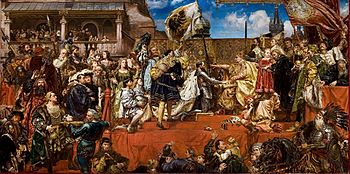
After some time, King Sigismund agreed to the offer. He said that Prussia would be a Polish fief (a territory held under a lord). This agreement was confirmed by a treaty in Kraków. Albert then made a personal promise to Sigismund I. On 10 February 1525, he was officially given the duchy for himself and his future children.
The important people of the land then met at Königsberg. They swore loyalty to the new duke. Albert used his power to promote Luther's teachings. This change did not happen without problems. Albert was called before the imperial court of justice but refused to appear. He was then declared an outlaw. The Teutonic Order chose a new Grand Master, Walter von Cronberg. He received Prussia as a fief at the imperial Diet of Augsburg. However, the German princes were busy with the Reformation, the German Peasants' War, and wars against the Ottoman Turks. So, they did not enforce the ban on Albert, and the opposition against him soon faded.
Albert was quite active in imperial politics. He joined the League of Torgau in 1526. He worked with other Protestants. He was among the princes who planned to overthrow Charles V after the Augsburg Interim in May 1548. However, because of money problems and his own choices, he did not play a big part in the military actions of this time.
The first years of Albert's rule in Prussia were quite good. He had some issues with the farmers. But he used the lands and treasures from the church to keep the nobles happy. For a while, he could also pay for the expenses of his court. He helped education by starting schools in every town. He also freed serfs (farmers tied to the land) who chose to study. In 1544, even with some opposition, he founded Königsberg University. He appointed his friend Andreas Osiander as a professor there in 1549. Albert also paid for the printing of the "Prutenic Tables" (astronomy charts) by Erasmus Reinhold. He also supported the first maps of Prussia by Caspar Hennenberger.
Osiander's appointment caused problems in Albert's later years. Osiander's ideas about faith were different from Luther's. This led to a big argument with Philip Melanchthon, who had supporters in Königsberg. These religious arguments soon caused trouble in the town. The duke strongly supported Osiander. The arguments grew wider. There were no more church lands to give to the nobles. Taxes were high, and Albert's rule became unpopular.
After Osiander died in 1552, Albert favored a preacher named Johann Funck. Funck, along with an adventurer named Paul Skalić, had a lot of influence over Albert. They gained much wealth at the public's expense. The chaos from these religious and political arguments grew. People worried about Albert's possible early death. They also needed to choose a regent (someone to rule for a young king), as his only son, Albert Frederick, was still very young. The duke was forced to agree to condemn Osiander's teachings. The biggest problem came in 1566. The important people of the land asked King Sigismund II Augustus of Poland, Albert's cousin, for help. The King sent a group to Königsberg. Skalić escaped, but Funck was executed. The question of who would be regent was settled. A specific form of Lutheranism was chosen and made binding for all teachers and preachers.
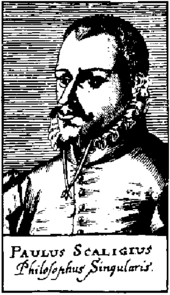
Albert had almost no power left. He lived for two more years. He died at Tapiau on 20 March 1568 from the plague, along with his wife. Cornelis Floris de Vriendt designed his tomb inside Königsberg Cathedral.
Albert wrote many letters and communicated with many important people of his time.
Albert's Impact
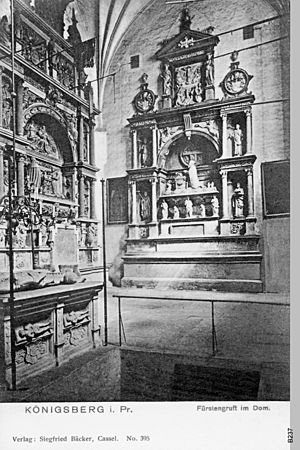
Albert was the first German nobleman to support Luther's ideas. In 1544, he founded the University of Königsberg, also known as the Albertina. It was meant to be a rival to the Catholic Krakow Academy. It was the second Lutheran university in the German states, after the University of Marburg.
A stone carving (relief) of Albert was placed over the Renaissance-style entrance of Königsberg Castle's southern wing. This was made by Andreas Hess in 1551. Another relief by an unknown artist was put on the wall of the Albertina's original campus. This image, showing the duke with his sword over his shoulder, was known as the popular "Albertus". It became the symbol of the university. The original was moved to the Königsberg Public Library to protect it. A sculptor named Paul Kimritz made a copy for the wall. Another version of the "Albertus" by Lothar Sauer was placed at the entrance of the Königsberg State and Royal Library.
In 1880, Friedrich Reusch created a sandstone statue of Albert at the Regierungsgebäude, an administrative building in Königsberg. On 19 May 1891, Reusch showed a famous statue of Albert at Königsberg Castle. It had the words: "Albert of Brandenburg, Last Grand Master, First Duke in Prussia." Albert Wolff also designed a statue of Albert on horseback. This statue was at the new campus of the Albertina. King's Gate also has a statue of Albert.
Albert was often honored in the Maraunenhof area in northern Königsberg. Its main street was named Herzog-Albrecht-Allee in 1906. Its town square, König-Ottokar-Platz, was renamed Herzog-Albrecht-Platz in 1934. This was to match its church, the Herzog-Albrecht-Gedächtniskirche.
Albert's Family
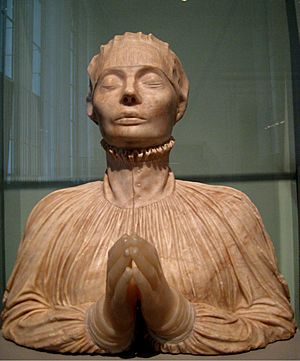
Albert first married Dorothea (born 1 August 1504, died 11 April 1547). She was the daughter of King Frederick I of Denmark. They married in 1526 and had six children:
- Anna Sophia (11 June 1527 – 6 February 1591), who married John Albert I, Duke of Mecklenburg-Güstrow.
- Katharina (born and died 24 February 1528).
- Frederick Albert (5 December 1529 – 1 January 1530).
- Lucia Dorothea (8 April 1531 – 1 February 1532).
- Lucia (3 February 1537 – May 1539).
- Albert (born and died March 1539).
He married a second time to Anna Maria (1532 – 20 March 1568). She was the daughter of Eric I, Duke of Brunswick-Lüneburg. They married in 1550. The couple had two children:
- Elisabeth (20 May 1551 – 19 February 1596).
- Albert Frederick (29 April 1553 – 18 August 1618), who became the next Duke of Prussia.
See also
 In Spanish: Alberto I de Prusia para niños
In Spanish: Alberto I de Prusia para niños


